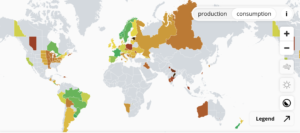What Energy Sources Do “Green” Countries Use? Hint – Not Wind or Solar
If renewable energy advocates actually believe that the United States has only a decade to reduce CO2 emissions before the planet is destroyed, their push for wind and solar energy strikes me as a bit confusing.
If reducing CO2 emissions is the goal, wouldn’t these advocates want to adopt power sources that have been proven to do so? Wind and solar, on their own, can’t even supply electricity at all times of the day, and need a significant amount of natural gas capacity on “standby” for when the wind isn’t blowing and the sun isn’t shining (which happens regularly).
To understand that there are better options out there to reduce CO2 emissions, and that the push for wind and solar energy is more of a lobbying effort on behalf of those who stand to make a fortune on state-mandated investments, here’s a list of all the green countries on the “electricitymap” app when I looked at 12:05 P.M. on March 1, 2019, and the percentage of each energy source these countries use to obtain a green status. This app details the emission levels from countries where data is available, displaying in green countries that have a majority of their electricity produced by carbon-free technologies.


Notice that there are only two countries – Costa Rica and El Salvador – that relied on wind or solar energy for more than 5 percent of electricity generation. The fact that no green country relies on wind and solar energy to obtain a “green” status, and instead utilize proven technologies such as nuclear and hydroelectric, is important for a couple of reasons:
1. Minnesota currently does not allow nuclear or hydroelectric plants (over 100 MWs) to contribute to the state’s renewable energy mandate of 25 percent, effectively limiting the potential carbon-free electricity sources that the state can use to wind and solar. Furthermore, a bill calling for Minnesota to be 100 percent carbon-free by 2050 also excludes existing nuclear plants and hydroelectric facilities over 100 MWs. If countries around the world are keeping CO2 emissions without wind and solar energy, then why are these essentially the only power sources other than biomass allowed in Minnesota’s renewable energy standard.
2. If the planet is truly in a crisis over climate change, this data suggests that the entire United States (with the exception of the state of Washington, which has plenty of hydroelectric capacity) is adopting a flawed solution in the effort to reduce greenhouse gas emissions by building wind and solar farms instead of nuclear and hydroelectric facilities. If the goal is to reduce CO2 emissions, then the only two sources of electricity proven to do so should be the means of achieving it.
When looking at states and countries that have turned to wind and solar instead of nuclear and hydroelectric power, we see that very little progress has been made in reducing CO2 emissions.
For instance, California has nearly 17,000 megawatts of wind and solar capacity – almost equaling the total installed capacity on Minnesota’s entire electrical grid – and it still isn’t a “green” state.
Why? Because there are times when wind and solar capacity is not producing any electricity at all, when all 17,000 megawatts on the California electricity market are sitting completely dormant. This means that California has enough fuel-based capacity on standby to cover for days when the wind isn’t blowing and nights when the sun isn’t shining. As a result, relying on wind and solar actually has done very little to sever California’s dependence on fossil fuel resources like natural gas, which still emits nearly 45 million metric tons of CO2 per year in the state. Additionally, California relies on importing nearly 28 percent of its electricity from neighboring states and Canada.
If instead, California relied on nuclear and hydroelectric, the state could have displaced existing fossil-fuel generating sources by retiring these facilities. This is because nuclear and hydroelectric power can supply electricity at all times of the day, regardless of the weather, and do not need the backup generation that wind and solar require.
And this is why it’s important not to follow the lead of Germany, where politicians have declared that all nuclear facilities will close by 2022 as the country begins to favor energy sources such as wind and solar. As a result, these same politicians are witnessing the country increase its coal and natural gas generation in order to fill the void for the loss of nuclear power, load-balance for intermittent wind generation, and meet increasing electricity demand, further distancing Germany from obtaining the much-desired “green” status.
If climate change is truly “science-based,” and we truly need a solution within twelve years before the planet is unalterably damaged, then the solution also needs to be science-based. To this end, the science is crystal clear – wind and solar energy sources are completely incapable of achieving the goals they were set out to tackle, mainly, reducing CO2 emissions.
As the table above explains, the formula for being a “green” country is simple – use nuclear and hydroelectric power.